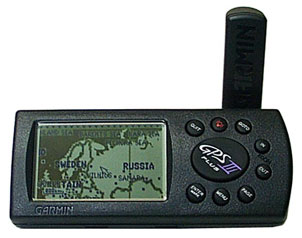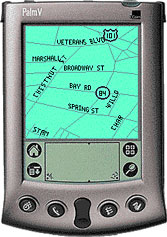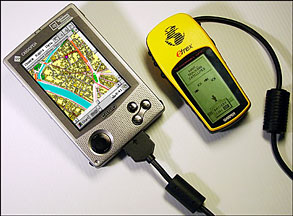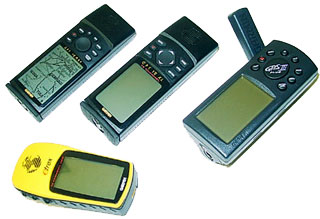It all started when that lazy beach told one friend the captain referred to satellite navigation devices. News is that the receivers have become quite compact and cost 300-400 dollars and sizes, and prices immediately conjures up thoughts of cellular communications, so that by itself has matured a question: how much monthly payment? As stated by the captain - no way! It was so surprising that information about the availability of services to remember. And then in the subconscious mind to this news were glued to various everyday situations, and at one point, when life was first exposed me to a GPS-receiver, I showed him the real buying interest.
Cases of life
At a friend's dacha just outside the fence begins a fairly large timber. Morning walk deep into the forest on well-trodden path over the desire to wander through the less civilized corners, resulting in a clear direction, "tries House" ("home" - it.) Has been lost. Not to say that was terrible (far away could not), but the discomfort was present. That would at least see the direction (azimuth) and distance to give friendship forever! Summer at the weekend really want to get out into the countryside. Lie somewhere on a sandy beach, swim ... However, in the nice days all known vacation spot is always crowded. In this case, it becomes an obsessive idea, if the turn from the main road in an unfamiliar primer, then you can get into a wonderful and completely "wild" place on the shore of a secluded lake. In this case, you need a good map (maybe even the military) and a clear understanding of where you are. Need skills orienteering, but I have this sport will never attract. But the good old "personal assistant" I'd love all the dirty work commissioned by the "fox hunting". By the way, mate skills are needed, and during long trips to Golden Ring Road, or travel on the sea. " Continuing to look into ambiguous direction signs and settlements - it is very responsible and tedious. And when at one point, a sign of "road repair" offers you to turn off the highway, one can only hope for a "caring and considerate" highway maintenance workers, who noted the detour route diverse signs and direction signs. In other words, you have to blindly rely on a cloudy alcohol and abusive thoughts brain proletarian road work. Agree, very uncomfortable. But if on the map, even if it is not enough detail, you could see his position, the problem of displacement in a given direction would be solved. Compass? Compass would be enough if you move a tank, but the roads are discharged fancy pretzels, and then the polar star will not manage. And how do you a story: you arrive in Italy. Take a rental car. Want to travel around the sights of Rome, a ride to the coast, and maybe you never know, and to get to Venice. And then there are numerous problems: the Italians for the most part do not speak in English and travel instructions give very stupid. Features markings and signs to unaccustomed confuse, so that huge amount of time necessary to spin in the same area to find the right place. It is clear that one can learn the Italian language and get used to one way traffic, but this takes time. In addition, for certain, in other cities and countries - just other features. What will happen now, and the Finnish study? What would help device that allows its own, without tedious negotiations with the aborigines, deciphering maps and road signs, get directions and move on it!
Advertising euphoria
Ironically, it is the latter situation (and not significantly more frequent domestic cases listed above), it was she who gave an impetus to ensure that surfaced in the head words of Captain of satellite navigation.And what happened? The first caught the eye of the consumer electronics store (it was not in Moscow) found a nice compact device that contains a map of the world with detailed, up to the street (!) And allows fat point mark your position on the map! Moreover, the machine knew where to find a decent hotel or a meal and tells you to stop the arrows, driving directions! To me it made a strong impression, but not enough to just lay out for a pilot pocket $ 600, however, the idea that we ought to find out more detail on the navigation system, the receivers and their cost, finally emerged and began to demand immediate access to the Internet. The first thing they found firm-mother of a beautiful box with the name of Garmin III Plus. Next went to competitors sites dedicated to GPS - the amount of information grew, like a snowball.
 |
It turned out that the system GPS (Global Positioning System - Global Positioning System) was developed and implemented from the U.S. military, to "hang" around the globe 24 satellites so that the American soldier, ship or plane could at any point on the globe to determine their exact coordinates. The system was open to "civilians", but with a strong coarsening of reading the receiver (in this case, the military removed the limitation of accuracy). The principle of the Global Positioning System is based on determining the distance to the satellite's signal delay time from him. Installed on satellites atomic clock, issuing the air "time signals. Thus, to determine the physical position of the receiver requires 3 satellites (assuming that the receiver is also an atomic clock) and 4 satellite - if not hours (and they could not be). In addition, the satellites being driven information about themselves, their coordinates, deviations from the orbit, and other complicated nonsense, which is processed by the receiver. Well, to improve positioning accuracy, uses a system of differential corrections. This service is for money, and Russia as a whole is not threatened (need a network of stations with known coordinates, which broadcast information to receivers on radio frequency - until this luxury available only to Petrograd). Having read various literacy classes in satellite navigation, I have become the ultimate fan of GPS systems and even confidently decided to have a domain named gps.ru, to carry education to the masses. It turned out that such a domain exists, and how! The presence of a powerful party in Russia overwhelmingly surprised. Discovered conference site gps.boston.ru struck by experienced and knowledgeable people, limiting information about various aspects of the Global Positioning System. Here, in particular, it appeared that pohodniki long been using handheld receivers for laying tracks and clear their passage. Hunters and fishermen noted the coordinates of the cherished hunting and fishing towns, and car safety exchange routes with an indication of gas stations, and that greatly amused, cops with radar. In addition, there are geodesics resources that explain the basics of map lovers of wisdom. However, along with joyous amazement, began to arise a feeling of fear that all the charms of handheld navigators - is often the advertising propaganda. It turned out that the receiver should see a large portion of the sky with satellites, and in direct line of sight, there should be no less than four, otherwise you may experience severe error. What's in a wooded area, as well as in the narrow streets with tall buildings, where the sky is poorly seen, the receiver can and does "lose-coordinate." In the cities, and possibly a large number of radio interference, interfering sure reception. All these clouds obscure the radiant sun began to GPS. Greatly added pessimism translated articles of the American journalist who has tried in the car navigation system. It is intrusive female voice made him turn where he would not, showed a large and beautiful screen that it rushes straight through the house, and eventually, under the guise of a trip to the library gave host to a wasteland.After this enthusiastic exclamations of users in the Internet-conference turned to me screaming fans who, like the Wright brothers at the beginning of the century, even on the table - but to fly! All the negative information was issued in a number of doubts are battering the mind.
Theoretical concerns
The first fear to the introduction of satellite navigation in the life of an amateur was a matter of sensitivity and reliability of the device. If the streets of the old town or in the woods, electronic Susanin considers the mission accomplished, then kill him - hence, at best, lose a few hundred dollars, and at worst - a big problem with the output, in the truest sense of the situation. The second question concerns the accuracy of maps. Having learned from bitter experience, walk on the road maps in a completely unfamiliar area, I could rightly assume that the streets are painted strings rather roughly correspond to their actual geographical location. If the card at one point, you "jump" from one street to another, to navigate just confused. In short, we had to learn how document maps represent the real picture of the area. However, if you find that accurate maps indeed correspond to, or only good (military) maps give a complete answer, you have to figure out where to get them. In this case, you must be sure that in any place (whether it be Europe, Moscow and Arkhangelsk Oblast) on hand will be carefully crafted cartographic material. Here with some thoughts I began to inquiries of experts, and then to research specific equipment.
Analysis of hardware and software
Consumer receivers can be divided into three groups: - First, the smallest, is the "sensors" that receive satellite data, process it in the form of standardized records issued in the port. - The second group includes devices with LCD display that shows the route, tracing the path, direction and speed, etc. Thus, leaving the road the car and memorized in the GPS-receiver, its location, can be safely disposed of into a thicket, there to roam your heart's content and flag devices of different mushroom places, then return safely to laid track to the car, and a year later without any difficulty to repeat the procedure using the stored information on nautical points (waypoints). - Third, the most expensive group of devices includes the possibility of navigating the map (moving maps). Cards are issued by manufacturers and third parties, and in some detail illuminate life abroad (in America and Europe). However you can not even look in the annals of corporate Russia - it's just a huge white spot. Just look at the detailed map of roads, which offers Microsoft a package AutoRoute, to learn that Moscow Ring Road and lives one to two or three highway, make maps of roads in our city look like a pacifist character.
 |
All of the above devices can connect to desktop and handheld computers. This means that even a primitive receiver in a standard CompactFlash, which is attached to your PDA or HPC, you can make a powerful navigator with a map. Participants recommended that the GPS-motion version of the proven personal experience with the Palm-cars. The most common products for navigation on this platform are the packages and Atlas HandMap. The first handles raster (Bitmap) images and can thus use any paper maps, scanned and downloaded to your computer. Product features rather wide: from scale maps and automatic podgruzki detailed maps of sites, to route planning and navigation on the map in the on-line using GPS. The second package uses a proprietary vector format of the cards, but allows "manual" the preparation and loading of cartographic material. Thus, in the arsenal of cards are cards for HandMap St. Petersburg and Moscow, created by enthusiasts from Russia.The guys who use handheld computers such as PalmPilot (Palm, Visor, and others like them), say that better could be wished, but I began to study the practical navigation with Pocket PC. The platform seemed to me more attractive to the task. Arguments in favor of Windows CE devices were as follows: - This is a separate class of handheld computers that have "vzroslye" interface and software. - It's not notebooks: use Windows CE as a notebook terribly uncomfortable, and Palm offers here 100 points ahead. This machine, "feeding" the standard formats of data from desktop machines and, more importantly, adapted for this! Try to stuff 80 MB of raster map data (detailed map of the Moscow region) in Palm - will not work. The only representative of the Palm kingdom, able to do so - is TRG. But I'm afraid he will not be able to digest such a voluminous piece of information, so even a standard "adult" format. Moreover, a popular collection of roads in Europe with detailed maps and databases for museums, hotels and restaurants and is published by Microsoft, "mate" for Pocket PC. Unfortunately, Pocket Streets can not work with GPS, but I hope this is temporary. In any case, world maps of this quality for the Palm platform simply does not exist. - The third argument in favor of Windows CE is the availability for the platform version of OziExplorer - a program that, according to Russian and foreign specialists, is today a leader in GPS-navigation. The developers also argue that in addition to Windows CE, no "pocket" of the platform will not be supported. The latter (shareware) software product, we'll talk, and while the basic arguments can be added: the presence of a bright color screen that plays cards almost in print, and a very voluminous work of Russian programmers who have created an excellent map of Moscow for Windows CE. PalmGIS package allows up to orient the house in Moscow, run routes, taking into account traffic signs and traffic jams, and work with the card in motion with the help of GPS-receiver. With practical exercises with the packet and the receiver Garmin eTrex company I started.
 |
Practical experience
Connecting without a problem in GPS-receiver to a Cassiopeia E-115 and setting her bag navigation Moscow PalmGIS, I started riding around the city. On the first day of doubt in the sensitivity and accuracy of the navigator vanished: priborchik, "thrown" to "torpedo" and randomly hanging out there, consistently "caught" from 3 to 6 satellites and showed the accuracy of 6-10 meters. This is enough to position your location on the map. When you see a map of Moscow just crawling through the streets of the circle, dying at intersections at traffic lights and turn with exactly one street to another, you feel just the joy of children! You guessed it, the card also had no problems: small errors in the suburbs do not confound the situation, and determine its location on the map has always been pretty easy. In the evening, when the city traffic died down, I tried to check the "conditions of poor visibility." It turned out that I can not remember where in Moscow are the narrow streets with tall, obscured the sky, the houses. Came to mind just blocks near Suharevka - where I ride. No coarsening of accuracy, signal loss and unexpected testimony maps I discovered. Left open the question of radio noise in the European cities with narrow streets and tall buildings, but otherwise all the issues raised in the "theoretical concerns" were filmed in one fell swoop! The next study was based on a package loaded with OziExplorer CE "kopeck piece (1 cm - 2 kilometers) of the Moscow Region and a trip to Sergiev Posad. The accuracy of mapping data was excellent! Track (path, "drawn by" GPS-navigator) lay precisely on the streets and highways. Only in one place, we "ran off the road," but this did not prevent navigation.It was interesting to watch as the arrow on the roundabouts, showing our position, began to unfold, just repeating the movement of the machine. Missed a turn in the same place, we drove on without any problems on the fork and rebuilding on the fly route and outlining a "bypass" route, came straight to Laura! It was nice overlooking the predictor sit and talk that through the two-kilometer bridge will then be possible to turn right! Thus, the accuracy of topographic maps, receiver sensitivity and a hardware-software does provide a comfortable navigation, and the possibility of a dignified exit from any difficult situation. However, in the way of preparation for the journey there are various subtle points to plan routes, preparation of graphic material and a map to the area. But these details - the following materials. The authors, translation:



